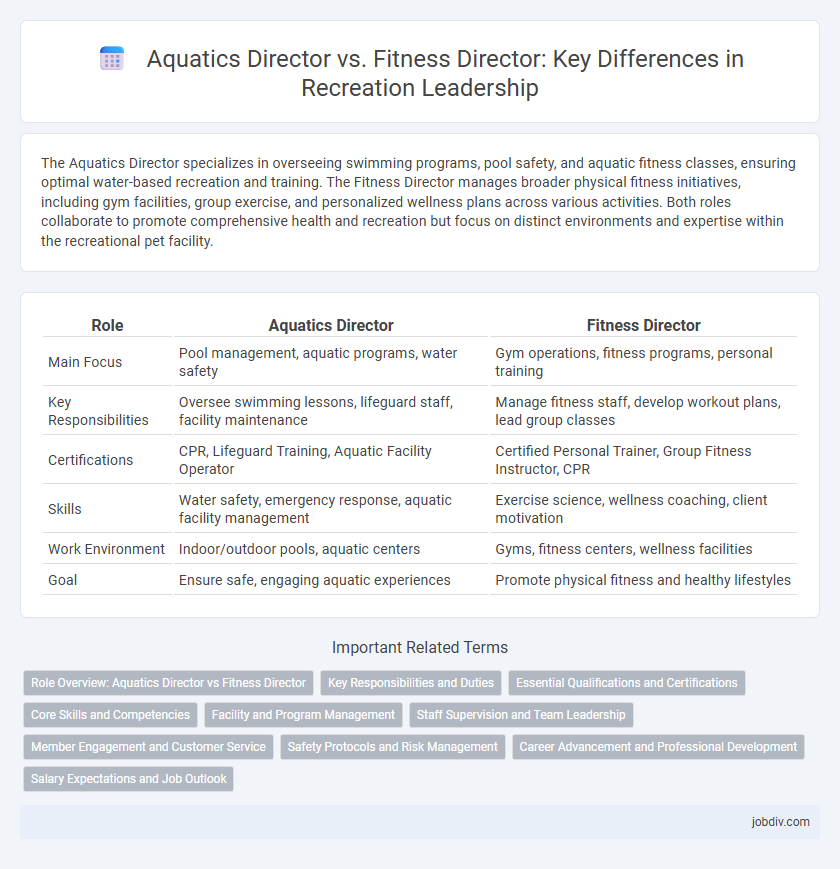The Aquatics Director specializes in overseeing swimming programs, pool safety, and aquatic fitness classes, ensuring optimal water-based recreation and training. The Fitness Director manages broader physical fitness initiatives, including gym facilities, group exercise, and personalized wellness plans across various activities. Both roles collaborate to promote comprehensive health and recreation but focus on distinct environments and expertise within the recreational pet facility.
Table of Comparison
| Role | Aquatics Director | Fitness Director |
|---|---|---|
| Main Focus | Pool management, aquatic programs, water safety | Gym operations, fitness programs, personal training |
| Key Responsibilities | Oversee swimming lessons, lifeguard staff, facility maintenance | Manage fitness staff, develop workout plans, lead group classes |
| Certifications | CPR, Lifeguard Training, Aquatic Facility Operator | Certified Personal Trainer, Group Fitness Instructor, CPR |
| Skills | Water safety, emergency response, aquatic facility management | Exercise science, wellness coaching, client motivation |
| Work Environment | Indoor/outdoor pools, aquatic centers | Gyms, fitness centers, wellness facilities |
| Goal | Ensure safe, engaging aquatic experiences | Promote physical fitness and healthy lifestyles |
Role Overview: Aquatics Director vs Fitness Director
An Aquatics Director manages all aquatic programs, facilities, and safety protocols, ensuring lifeguard staff training and swimming lesson quality. A Fitness Director oversees fitness programs, personal training services, and gym operations, focusing on member engagement and wellness initiatives. Both roles require leadership skills but specialize in their respective domains of aquatic activities versus overall fitness and health promotion.
Key Responsibilities and Duties
The Aquatics Director oversees the management and safety of all aquatic programs, including pool maintenance, lifeguard supervision, and swim lesson coordination, ensuring compliance with health and safety regulations. The Fitness Director is responsible for developing and implementing fitness programs, managing personal trainers, and maintaining gym equipment and facilities to promote member health and wellness. Both roles require strong leadership, staff training, and budget management to enhance recreational services and member satisfaction.
Essential Qualifications and Certifications
Aquatics Directors typically require certifications such as Lifeguard Training, CPR/AED, Water Safety Instructor, and Pool Operator licenses, emphasizing specialized water safety and aquatic facility management skills. Fitness Directors often hold certifications from recognized organizations like ACE, NASM, or ACSM, focusing on personal training, group fitness instruction, and wellness program development. Both roles demand leadership experience, strong communication skills, and knowledge of health and safety regulations relevant to their specific environments.
Core Skills and Competencies
Aquatics Directors excel in water safety management, aquatic program development, and certified lifeguard supervision, ensuring compliance with health regulations and emergency response protocols. Fitness Directors specialize in exercise physiology, personalized training program design, and wellness coaching, promoting client motivation and injury prevention. Both roles demand strong leadership, communication, and organizational skills to effectively manage staff and coordinate recreational activities.
Facility and Program Management
An Aquatics Director specializes in managing swimming pool facilities, ensuring safety protocols, water quality, and lifeguard supervision, while also developing aquatic programs such as swim lessons and water aerobics. A Fitness Director oversees gym and wellness center operations, including equipment maintenance, fitness class scheduling, and personal training programs. Both roles require strong facility management skills but differ in program focus, with Aquatics Directors emphasizing aquatic safety and instruction, and Fitness Directors prioritizing overall physical fitness and wellness activities.
Staff Supervision and Team Leadership
An Aquatics Director oversees lifeguards, swim instructors, and pool maintenance staff, ensuring safety protocols and aquatic program quality, while a Fitness Director manages personal trainers, group fitness instructors, and wellness coaches to enhance member engagement and fitness outcomes. Both roles require strong team leadership skills, but the Aquatics Director emphasizes risk management and emergency response training, whereas the Fitness Director focuses on motivation techniques and performance tracking. Effective staff supervision in these positions involves scheduling, training, and performance evaluation tailored to the unique demands of aquatic and fitness environments.
Member Engagement and Customer Service
Aquatics Directors specialize in managing swimming programs and aquatic facility operations, emphasizing safety protocols and skill development to enhance member engagement. Fitness Directors oversee broader gym activities, tailoring fitness plans and wellness programs to meet diverse member needs and boost customer satisfaction. Both roles require strong communication and leadership skills to foster a welcoming environment and improve overall recreational experience.
Safety Protocols and Risk Management
Aquatics Directors implement specialized safety protocols such as lifeguard training, water quality monitoring, and emergency response drills to prevent drowning and waterborne illnesses. Fitness Directors focus on injury prevention through proper equipment maintenance, staff certification in CPR and first aid, and adherence to facility cleanliness standards. Both roles require comprehensive risk management plans to ensure participant safety and regulatory compliance in their respective environments.
Career Advancement and Professional Development
Aquatics Directors typically advance by gaining certifications such as Certified Pool Operator and American Red Cross Water Safety Instructor, which enhance leadership in aquatic facility management and safety compliance. Fitness Directors pursue career growth through certifications like ACE Certified Personal Trainer and NASM Certified Fitness Instructor, focusing on program development and client engagement strategies. Both roles benefit from specialized training and experience that foster professional development, enabling progression into senior management or specialized wellness coordinator positions.
Salary Expectations and Job Outlook
Aquatics Directors typically oversee swimming facilities and may earn an average salary ranging from $50,000 to $80,000 annually, reflecting specialized water safety and program management skills. Fitness Directors, responsible for broader health and wellness programs, often command salaries between $55,000 and $85,000, benefiting from higher demand in the growing fitness industry. Job outlook for Fitness Directors is projected to grow faster due to rising health awareness, while Aquatics Directors experience steady demand linked to recreational facility development and aquatic program expansion.
Aquatics Director vs Fitness Director Infographic

 jobdiv.com
jobdiv.com